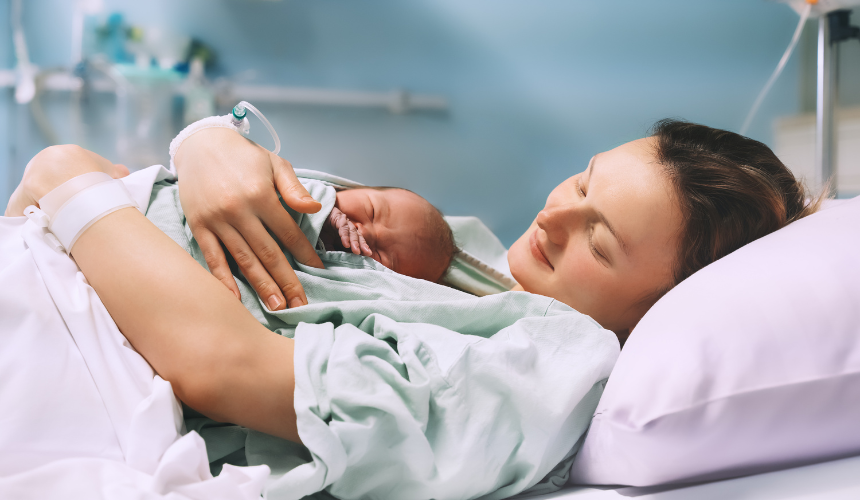Normal Delivery
Normal delivery, also known as vaginal delivery, is the most common method of childbirth and typically occurs without the need for medical intervention
Here's a description of the process
-
Onset of Labor : - Labor begins with the onset of regular contractions of the uterus, which gradually increase in frequency, duration, and intensity. These contractions help to thin and dilate the cervix, allowing the baby to move through the birth canal.
-
First Stage of Labor : - The first stage of labor is characterized by the dilation (opening) of the cervix. This stage is further divided into early labor, active labor, and transition. During early labor, contractions may be irregular and mild, and the cervix begins to efface (thin out) and dilate. In active labor, contractions become more frequent and intense, and the cervix continues to dilate, usually progressing from around 4 to 10 centimeters. Transition marks the end of the first stage, with intense contractions and rapid cervical dilation, often reaching 10 centimeters.
-
Second Stage of Labor : - The second stage of labor begins when the cervix is fully dilated and ends with the birth of the baby. During this stage, the mother will experience strong urges to push, and with each contraction, she will actively push to help the baby move through the birth canal. The baby's head emerges first, followed by the shoulders and the rest of the body.
-
Delivery of the Placenta : - After the baby is born, the third stage of labor involves the delivery of the placenta (afterbirth). Contractions continue, helping the placenta to separate from the uterine wall. The healthcare provider may assist by gently pulling on the umbilical cord to deliver the placenta, which is then examined to ensure that it is intact.
-
Recovery : - After the delivery of the placenta, the mother and baby are monitored closely for any signs of complications. The healthcare team will provide immediate care for any tears or lacerations, and the mother may receive medications to help control bleeding. Skin-to-skin contact between the mother and baby is encouraged to promote bonding and breastfeeding initiation.
-
Postpartum Period : - Following delivery, the mother will enter the postpartum period, during which her body undergoes various changes as it transitions from pregnancy to the postpartum state. This period includes physical recovery, hormonal adjustments, and emotional adaptation to parenthood.
Benefits for the Mother
-
Faster Recovery :- Compared to cesarean section, vaginal delivery typically involves a shorter hospital stay and faster recovery time. Mothers who deliver vaginally often experience less postpartum pain and discomfort compared to those who undergo surgery.
-
Lower Risk of Complications :- Vaginal delivery is associated with a lower risk of certain complications, such as infections, blood clots, and surgical injuries, which are more common with cesarean section.
-
Promotion of Maternal Bonding :- Many mothers report feeling a greater sense of empowerment and accomplishment after a vaginal birth, which can positively impact maternal bonding and postpartum mental health.
-
Favorable for Subsequent Pregnancies :- Vaginal delivery is less likely to impact future pregnancies compared to cesarean section. Mothers who deliver vaginally may have fewer restrictions on future birth options and may be candidates for vaginal birth after cesarean (VBAC) in subsequent pregnancies.
-
Natural Hormonal Release :- During vaginal delivery, the body releases hormones such as oxytocin, also known as the "love hormone," which promotes uterine contractions and bonding between mother and baby.
Benefits for the Baby
-
Lung Expansion :- The compression of the baby's chest during passage through the birth canal helps expel fluid from the lungs, facilitating the transition to breathing air outside the womb. This process may reduce the risk of respiratory complications after birth.
-
Microbiome Development :- Passage through the birth canal exposes the baby to beneficial bacteria from the mother's vaginal and intestinal flora, which contributes to the development of the baby's immune system and gut microbiome.
-
Stimulation of Senses :- The experience of passing through the birth canal stimulates the baby's senses and may promote alertness and responsiveness shortly after birth.
-
Lower Risk of Neonatal Intensive Care :- Babies born vaginally are less likely to require admission to the neonatal intensive care unit (NICU) compared to those born by cesarean section, particularly for respiratory issues and infection.
-
Breastfeeding Initiation :- Skin-to-skin contact and early breastfeeding initiation are often facilitated more easily after vaginal delivery, which can support successful breastfeeding and mother-baby bonding.

